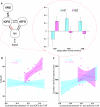Altered brain dynamics of facial emotion processing in schizophrenia: a combined EEG/fMRI study
- PMID: 39819992
- PMCID: PMC11739413
- DOI: 10.1038/s41537-025-00553-w
Altered brain dynamics of facial emotion processing in schizophrenia: a combined EEG/fMRI study
Abstract
Facial stimuli are relevant social cues for humans and essential signals for adequate social interaction. Impairments in face processing are well-documented in schizophrenia and linked to symptomatology, yet the underlying neural dynamics remain unclear. Here, we investigated the processing and underlying neural temporal dynamics of task-irrelevant emotional face stimuli using combined EEG/fMRI in 14 individuals with schizophrenia and 14 matched healthy controls. Specifically, fMRI-informed region-of-interests were subjected to EEG-Dynamic Causal Modeling (DCM) analyses. Among six fMRI-informed EEG-DCM models, alterations in effective connectivity emerged between the primary visual cortex (V1) and the left occipital fusiform gyrus (lOFG). Specifically, individuals with schizophrenia showed enhanced backward connectivity from the lOFG to V1 for stimuli preceded by fearful (but not happy or neutral) faces. Connectivity strength was strongly correlated with self-reported difficulties in comprehending, processing, or articulating emotions (as assessed by the Toronto Alexithymia Scale-20) in individuals with schizophrenia but not in healthy controls. Enhanced backward connectivity from the lOFG to V1 potentially indicates heightened attention towards fearful surroundings and a propensity to assign salience to these stimuli in individuals with schizophrenia. The link to TAS-20 scores indicates that this neural deficit has real-world implications for how individuals with schizophrenia perceive and relate to their emotions and the external world, potentially contributing to the social and cognitive difficulties observed in the disorder.
© 2025. The Author(s).
Conflict of interest statement
Competing interests: The authors declare no competing interests.
Figures





Similar articles
-
Alexithymia and automatic processing of facial emotions: behavioral and neural findings.BMC Neurosci. 2020 May 29;21(1):23. doi: 10.1186/s12868-020-00572-6. BMC Neurosci. 2020. PMID: 32471365 Free PMC article.
-
Facial emotion processing in patients with schizophrenia and their non-psychotic siblings: a functional magnetic resonance imaging study.Schizophr Res. 2012 Feb;134(2-3):143-50. doi: 10.1016/j.schres.2011.10.019. Epub 2011 Nov 22. Schizophr Res. 2012. PMID: 22113155
-
Task-irrelevant fear enhances amygdala-FFG inhibition and decreases subsequent face processing.Soc Cogn Affect Neurosci. 2016 Sep;11(9):1440-8. doi: 10.1093/scan/nsw054. Epub 2016 Jun 5. Soc Cogn Affect Neurosci. 2016. PMID: 27272198 Free PMC article.
-
Distributed and interactive brain mechanisms during emotion face perception: evidence from functional neuroimaging.Neuropsychologia. 2007 Jan 7;45(1):174-94. doi: 10.1016/j.neuropsychologia.2006.06.003. Epub 2006 Jul 18. Neuropsychologia. 2007. PMID: 16854439 Review.
-
Fusing concurrent EEG-fMRI with dynamic causal modeling: application to effective connectivity during face perception.Neuroimage. 2014 Nov 15;102 Pt 1:60-70. doi: 10.1016/j.neuroimage.2013.06.083. Epub 2013 Jul 9. Neuroimage. 2014. PMID: 23850464 Review.
References
-
- Chan, R. C. K., Li, H., Cheung, E. F. C. & Gong, Q. Impaired facial emotion perception in schizophrenia: a meta-analysis. Psychiatry Res178, 381–390 (2010). - PubMed
-
- Marwick, K. & Hall, J. Social cognition in schizophrenia: a review of face processing. Br. Med. Bull.88, 43–58 (2008). - PubMed
-
- Barkl, S. J., Lah, S., Harris, A. W. F. & Williams, L. M. Facial emotion identification in early-onset and first-episode psychosis: a systematic review with meta-analysis. Schizophr. Res.159, 62–69 (2014). - PubMed
Grants and funding
- GRK1328/Deutsche Forschungsgemeinschaft (German Research Foundation)
- 269953372/GRK2150/Deutsche Forschungsgemeinschaft (German Research Foundation)
- GRK1328/Deutsche Forschungsgemeinschaft (German Research Foundation)
- 269953372/GRK2150/Deutsche Forschungsgemeinschaft (German Research Foundation)
- 269953372/GRK2150/Deutsche Forschungsgemeinschaft (German Research Foundation)
- 269953372/GRK2150/Deutsche Forschungsgemeinschaft (German Research Foundation)
- GRK1328/Deutsche Forschungsgemeinschaft (German Research Foundation)
- 269953372/GRK2150/Deutsche Forschungsgemeinschaft (German Research Foundation)
- GRK1328/Deutsche Forschungsgemeinschaft (German Research Foundation)
- 269953372/GRK2150/Deutsche Forschungsgemeinschaft (German Research Foundation)
LinkOut - more resources
Full Text Sources

